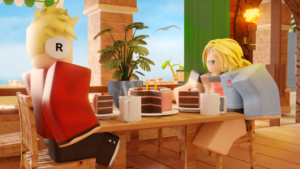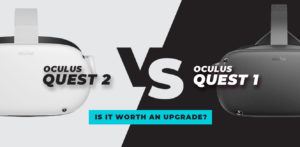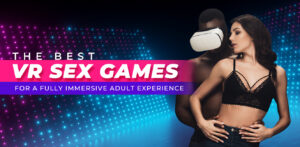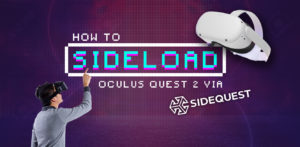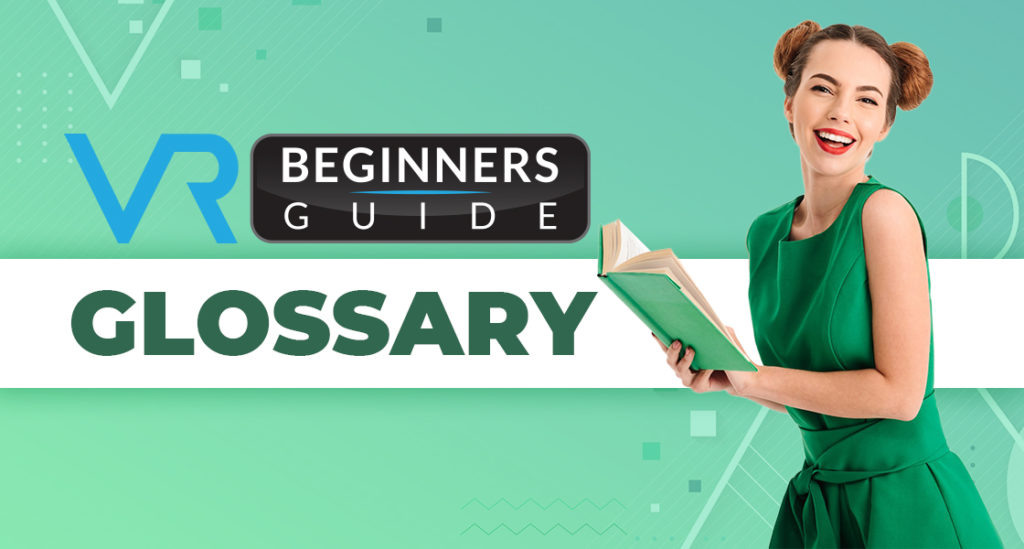
Virtual reality content and associated games, applications and guides can contain a lot of buzz words and acronyms. It is sometimes quite confusing to read through the jargon without fully knowing what each buzz word means. We’re here to help! Below is a comprehensive VR glossary that explains terms used commonly in virtual reality (VR) discussions.
All of these phrases can be found sprinkled throughout the content available on our website. Each term is explained in simple, easy to understand language making this glossary great for newcomers to virtual reality. Our glossary is in alphabetical order to make finding particular terms easier. Enjoy!
[no_toc]
¦#¦A¦B¦C¦D¦E¦F¦G¦H¦I¦J¦K¦L¦M¦N¦O¦P¦Q¦R¦S¦T¦U¦V¦W¦X¦Y¦Z¦
180 Video
Motion videos that allow the user to look left and right on vertical and horizontal axis. The visuals or screen edges cover a span of 180 degrees
360 Video
Motion videos that allow the viewer to look in all directions even behind. Full circle views covering 360 degrees of movement. No edge to the image or video can be found
3D Tour
A 3D rendered world that allows for a walkthrough. Used to visually promote concepts or guided virtual tours within a 3D digital space.
3DOF
Three degrees of freedom is a term used in virtual reality to describe the level of interaction a player can have in a 3D environment. Three degrees means the play can look up and down, left and right, and also pivot left and right. The player’s movements within the 3D space are considered static.
6DOF
Six degrees of freedom is the term used in VR to describe the level of interaction a player or user can have with the digital environment. The six degrees include looking left and right, looking up and down, pivoting left and right, movement forward and back, and moving left and right. This is considered as a full movement within a 3D space whereas 3dof has the player static within a 3D space.
Agency
Player agency refers to the amount of impact or interactivity a player can have within a 3D world. Low-level agency is considered poor immersion as interactions are low or unrealistic. When the world reacts to your actions in a realistic manner, it’s considered as having good player agency.
Aim Controller
An additional controller for PSVR that helps solve the lack of analog control while also providing satisfying shooting mechanics. A large rifle-like gun that offers realistic gameplay and motion for first-person shooters in virtual reality.
Airplay
A wireless untethered solution for PC virtual reality users. Airplay uses shared wifi to link and stream content from your PC to your VR headset. A high-speed broadband connection is advisable to reduce latency and provide a one-to-one gaming experience for the player.
Anti-Aliasing
Anti-aliasing is the method to help reduce or eliminate jagged edges on polygons that appear in objects in games. There are several different types of anti-aliasing methods, each with its own pros and cons. A lot of PC and VR games have an in-game window where you’re able to adjust graphics settings, including anti-aliasing.
AR Glasses
Augmented reality wearable glasses. The glass displays a digital display layer over see-through lenses. Allows for users to have information displayed in front of their eyes while still being able to see the physical environment around them.
Aspect Ratio
The dimensions of which a video is displayed. The length and width of the image on the screen are known as the aspect ratio. Some ratios aren’t designed to be displayed on smaller or larger screens and may stretch the image or distort the experience.
Augmented Reality
A process that allows a digital object or environment to be superimposed over what we normally see. The user’s view of the real world is not obscured but enhanced by this added information. Filters in Snapchat are an example of augmented reality where funny objects are placed over the live portrait image of the user’s face.
Avatar
A digital character created usually by the player that represents them in the virtual world. They act as the player’s muse or vessel when playing games. Digital avatars have also become popular in social spaces like VRChat and YouTube.
Binaural Audio
Binaural audio is sound that has been recorded in stereo through two different microphone setups. This allows for a 3D sound experience and gives the illusion that the sound the player is hearing is coming from different places. This can greatly help with immersion and player’s can get a real sense of the direction from which the sound is meant to be coming from.
Blinders
Virtual reality settings that block out some of the user’s peripheral vision. Helps reduce motion sickness at the expense of immersion in virtual reality. The player becomes focused on the portion of the screen where gameplay is taking place while somewhat reducing the illusion of being within the play space.
Cave
Cave Automatic Virtual Environment refers to any 3D constructed virtual space created that takes on the digital version of a room or play space. Featuring walls floors and ceiling, it is a digital play area for virtual reality users to interact and feel immersed within.
Click Turning
Motion setting that helps reduce motion sickness. In-game movement from side to side is handled in increments rather than in smooth motion. The screen blanks for a moment and the user’s view is turned in set degrees. Improves motion sickness at the expense of some immersion.
Cockpit
A cockpit is a small seated compartment typically seen in planes, cars, or boats. In VR terms a cockpit can be a digital seated play space that mimics some of the above for the player. As the player is seated in both scenarios (real and virtual) the level of immersion a player can feel in a virtual cockpit is very realistic. This makes driving or flying simulators in VR very popular.
Controllers
Input devices that allow the user to interact and navigate within a 3D environment. Some controllers have sensors to allow for accurate one-to-one tracking and allow haptic feedback to provide more realistic virtual reality experiences.
CPU
Central processing unit. This is the brain of the computer that handles most of the calculations and processes. High-end CPUs are needed for decent VR experiences.
Defined Play Area
A user-created space for playing safely in VR. Typically it’s encouraged to remove any breakables or tripping hazards and keep your play area empty to allow user to move easily. Play area can usually be mapped out by drawing a perimeter with your controller.
Display Port
Found mostly on the back of the GPU graphics cards on a PC or on the side panel of a laptop. Display ports are generally used for all PCVR headsets to connect directly to the PC. It is the port used to link your headset to your PC and display what would normally appear on your gaming monitors.
Dollhouse View
Dollhouse view refers to the top-down or god-mode view a player can have over a digital 3D environment within virtual reality. Typically used for creation mode or engineering within games or applications it gives the user an unprecedented level of control of the 3D objects in front of them.
Eye Tracking
Inside-out cameras within the virtual reality headset can follow the movement of the user’s eyes. This can be used to mimic facial expressions or reduce computations as only areas the eyes are looking at are needed to be rendered on the fly
Facial Recognition
A computer process that can recognize and identify users from their faces alone. Pinpointing nodes on the face like eyes and nose to distinguish who is playing or using the device. Established technology was first seen in smartphones but has been adopted to many headsets as they too already have built-in cameras and sensors capable of distinguishing individual faces or features.
Field of View
The amount a player can see in their peripheral vision. I larger field of view leads to a more realistic experience. A small field of view leads to what’s known as the goggle effect. If the headset lenses are small and close together it’s typical for the user to constantly see the black edges of the lens frame which can break immersion.
FMV
Full motion video. Otherwise typically known as a cut scene in most games. Typically highly polished videos to help enhance a narrative or plot point in games. May also be used for heightened action set pieces or simply to impress the viewer.
Foveated Rendering
Foveated rendering is a technique that uses an eye tracker within the virtual reality headset to reduce the rendering workload by greatly reducing the image quality in the peripheral vision (outside of the zone gazed by the fovea). Only the portions of the screen that the user is looking at need to be rendered fully while anything in the periphery can be rendered at a reduced quality rate with relieves some pressure on the CPU. Great for lower spec headsets like the Quest.
FPS
Frames per second is the number of frames shown every second while games or apps are in motion. The higher the frame rate, the smoother and more realistic the experience. Helps to keep immersion but only high-end graphics cards are capable of high frame rates.
Frame Rate
The speed that frames are displayed to the viewer. The higher the frame rate, the more realistic the overall experience. Low frame rates usually mean jerky movements or slow down in gameplay. See FPS for more information.
Gamification
Gamification is the strategic attempt to enhance systems, services, organizations, and activities by creating similar experiences to those experienced when playing games in order to motivate and engage users. If an experience feels more like a gaming experience, then users will stay on for longer and have their interests held for a longer period of time.
Gesture
Hand or head movements that allow users to communicate in-game. A nod of the head can apply consent for example. A wave of your hand can signify a hello etc. Recent VR technology allows for hand gestures without the use of controllers. Cameras can determine the movement and shape of your hands and mimic them in-game. It also allows for certain gestures to control functionality for menu navigating and manipulation of objects.
GPU
Graphical Processing Unit. Similar to CPUs but more dedicated to displaying graphics, especially in virtual reality. Nvidia has become the industry standard and leader in the creation of graphics cards capable of rendering high-quality gaming experiences for VR users.
Graphics Card
The graphics card is vital for PCVR. Handles most of the resolution and frame rate for VR gaming. Can render high-quality images and maintain frame rates with consistency to allow for an enjoyable gaming experience. High-end examples like Nvidia 3060Ti are in high demand amongst gamers to boost their PC power.
Guardian Boundaries
Set out play area. A preset perimeter is marked out by the user and the guardian helps users not extend beyond the designated play area. Boundaries show up once the users strays too close to the edges of their play area. Acts as a helpful reminder for positional awareness.
Hand Tracking
External cameras on headsets can now track and recognize simple hand movements. This negates the need for controllers or other peripherals. Used for menu navigation and object manipulation within games.
Haptic Suit
A wearable piece of clothing with built-in sensors and vibration points. Most designs come in the form of a combat vest which is connected to your headset or PC and worn by the user. Used in conjunction with VR applications to mimic feedback and react to in-game collisions. Helps boost realism and immersion. Players feel the impact on different areas of their bodies in time with the in-game action.
Haptics
Motors with built-in sensors that control vibrations. Offers realistic feedback for users and usually come with adjustable vibration controls. Haptic vibration is superior to regular rumble packs as it can control the intensity and pinpoint a particular area to focus on with the feedback
Head-Mounted Display
In virtual reality, the head-mounted display refers to the headset you put over your face. The lenses inside the headset show what you would typically see on a gaming screen. The VR capabilities allow for 3D images to be displayed within the headset which boosts the players’ immersion and makes them feel like they’re inside the game itself
Head Tracking
Sensor and camera mapping that allows accurate interpretations of your head movements that translate to what you’re seeing and experiencing within your headset.
Headset
The virtual reality device you put on your head or face to experience virtual reality.
HUD
Heads up display. Used in many cases to display relevant information to the user. Usually in an overlay format.
Immersion
The level of belief within a virtual reality world that helps trick your mind into believing that what you’re experiencing is real.
Inside Out Tracking
The method of tracking that allows cameras on a device to view and monitor your actions within your play area. Can realistic map movements of your body as you play.
IPD
Inter-pupillary distance is the measure of distance between the center of both your eyes. This measurement can be used to accurately adjust your VR lenses to produce the most accurate and clear picture available.
Latency
The time difference between an input being pressed and it getting carried out on screen. Low latency leads to more accurate gameplay.
LCD
Liquid Crystal Display. The common technology used in screens including some VR lenses. The image becomes visible once electricity passes through the crystals. Cheaper than OLED but with some drawbacks. Blacks look grey as the screen is always lit. There is never an absence of light so colors can look lighter and sometimes even washed out when compared to OLED.
Lenses
The glass oculars used to display an image in front of your eyes in VR. The screen technology for lenses used in VR can vary from LED, OLED, and even LCD. Keeping lenses clean, scratch-free, and out of direct sunlight is essential for maintaining your headset.
Light Field
A light field captures the orientation, direction, color, and intensity of all rays of light within a scene. A light field camera preserves the direction of each ray of light entering the camera and captures all that information in one image. This same technology can be incorporated into the lens technology of VR headsets.
Locomotion
The method of traversal where you gain momentum and speed the more you interact. Used in fitness or parkour-type games mostly.
Meta
Rebranded name for the suite of Facebook products. Pertains particularly to their virtual reality products
Metaverse
Online digital social space. Mostly concept at the moment with different companies working on their own virtual spaces. Mark Zuckerburg is hoping to create an overarching metaverse for social and commercial uses within a virtual space.
Mixed Reality
Similar to augmented reality. A layer of digital optics is displayed across a lens while still allowing the user to see physical objects in the real world. Can be used to map 3D virtual objects overlayed in the real world.
Motion Sickness
A wave of nausea caused by the brain not fully computing the motion in VR compared to the stationary position of a person’s head or body. Feeling of sickness in the stomach that can get progressively worse during VR gameplay. Root ginger is said the help relieve bouts of nausea.
Move Controllers
Two wand-like controllers for the PSVR. The sensor bulbs on top of each controller are visible and picked up with the PlayStation camera tracking. This allows for in-game tracking of your hand and arm movements as long as the bulbs stay in line of sight of your PlayStation camera.
NFTs
Non Fungible Tokens are digital assets that are generally used to represent real world objects or copyright/ownership. The technology to record ownership is the same as blockchain crypto tech. NFTs can also be used as digital bearer bonds allowing a record of ownership of assets.
NPCs
Non Player Characters are AI-controlled characters within a game that help progress storylines or in some instances serve to conceive a more realistic sandbox world. Some NPCs will have realistic daily routines to help the world feel more realistic and lived in.
OLED
Organic Light Emitting Diode. Technology behind a lot of VR lenses and TVs on the market currently. Allow for the display of rich colors while also blocking or allowing light saturation which leads to dark blacks and brighter whites across the color spectrum.
Omni Directional Thread Mill
A stationary device that allows the user to walk on the spot at any directional while maintaining realism. Allows for movement within a VR environment without physically leaving the thread mill. KatVR current brand leader in manufacturing consumer-friendly Omni directional thread mills.
Parallax
Parallax is the term given to the perceived displacement or the difference in the apparent direction of an object as seen from two different points, not on a straight line with the object especially. The angular difference in direction of a celestial body as measured from two points on the earth’s orbit.
PCVR
Personal Computer Virtual Reality. A headset that needs to utilize the power of a PC to work correctly. The VR uses the PC as the brain using the GPU and CPU to handle all computations. Generally, PCVR headsets are tethered/wired for a one-to-one performance however streaming across Wi-Fi is also possible with more recent PCVR headsets. This utilizes the power of the PC while also offering freedom of movement with no connected cables hindering the player. Needs reliable fast broadband to work correctly.
Peripherals
Refers to any hardware beyond the headset that allows for further immersion within VR. Controllers, cameras, haptic suits, aim controllers, gun attachments, and wearable motion sensors would all be considered peripherals.
Positional Audio
Positional Audio is the addition of dampening or distortion that places the people talking to you in a certain position relative to your own depending on their actual position in the game you are playing. This way you can hear the person as if their actual avatar in-game was talking to you. To put it in simple terms, if you’re facing someone, you will hear them more clearly but if you turn away, the sound of their voice become lower and less distinguished.
PSVR
Playstation virtual reality (PSVR) is a term reserved for the VR headset experience launched by Sony for use with the PS4 and PS5 consoles. Utilizing old and new technology including move controllers and eye cameras, Sony developed a front-facing working console VR experience for users. Lacking some of the power and moveability of more recent VR headsets, Sony still stands out for creating first-party VR experiences and games that are on par with any other competitors. PSVR2 has been announced and we’ll soon have a new generation of console VR with hopefully forward-thinking technology under the hood.
Refresh Rate
Refresh rate is the speed at which the images on the screen are re-displayed. It is measured in units of hertz (Hz) and a refresh rate of 90 or more hertz per second is standard for most VR experiences. The faster the refresh rate, the less visible frame skips or judder during gameplay. Fast refresh rates help reduce motion sickness.
Resolution
Term used when talking about screen resolution. It’s the number of horizontal and vertical pixels used to create an image whether still or in motion. The higher the amount of pixels, the more detailed and clearer the image on the screen. 4K resolution has become mainstream which offers a crisp sharp detailed experience for flatscreen users. As VR screens are closer to your face, 4K has become a standard requirement with higher-end units offering up to 8K resolution per eye for enhanced gaming experiences.
Reticle
Small on-screen indicator such as a dot or crosshair that indicates where the player is focussed. Can be used to point toward objects or in-game characters that can be interacted with. Also in first person shooter games, it is used to show where the player is aiming their weapon and where most likely the bullets or projectiles will end up going after launch.
Room Scale
Room scale refers to the play area needed/utilized by a game or app. If a game’s play mode is referred to as room scale then it is expected that the player will be moving around their play area and not remaining stationary during play.
Screen Door Effect
A dotted effect in a VR users vision. Caused by the gaps in pixels being so close to the users face that the black parts in between each pixel are noticeable. The overall effect is like a mesh across the image similar to what you might see
Side by Side
Video display option within virtual reality. Two images with slightly different angles are displayed side by side, one in each lens. The effect is a 3D image with depth which helps to enhance immersion within VR.
Sideload
Sideloading is a method for adding apps and games to your Quest 2 without using the official Oculus store. A method for trying out third-party products or free content not typically available in the main store.
Skybox
The 3D rendered sky area in a digital world. The Skybox is usually separate from the game level design. This means when areas of the map are in view, the Skybox is always present. Moving sky boxes with changing lighting and weather conditions helps to elevate a digital world.
Smooth Turning
Turning in-game is relative to turning in the real world. No frames are blurred or blanked out. Can cause motion sickness as the brain can’t understand why you’re not moving in reality. Great for immersion once the user has become used to virtual reality.
Spherical Video
Another term used to describe 360-degree videos. The viewer can orientate their view in any direction and the video is all-encompassing on horizontal and vertical planes.
Standalone Headset
Refers to a VR headset that does not need any other equipment to work. No need for a PC or console to help as all the technology is internal including the processor and internal storage. Small space can mean less processing power than a regular PC however the pick-up and play elements combined with the lack of wires are very appealing to most consumers. Not needing additional equipment to run makes the initial pricing very transparent for buyers.
Stereoscopic
Stereoscopy, or as it’s more commonly known stereoscopic imaging, is a technique used to enable a three-dimensional effect. This adds the illusion of depth to a flat image. Stereopsis, commonly (if imprecisely) known as depth perception, is the visual perception of differential distances among objects in one’s line of sight. Stereoscopic visuals within VR allow the user to feel like they are interacting within a 3D world.
Teleportation
A method of traversal within a 3D environment in virtual reality. The player can point to a spot in the distance and click a button to warp instantly to that spot. This ease of movement does break immersion for users however it can be less intensive than smooth movement and can help reduce motion sickness for some players.
Touch Controller
Originally developed by Oculus and now Meta, the touch controllers are gripped in each hand. Each controller has built-in tracking and sensors to work in conjunction with the headset for accurate mapping and positioning. The buttons and grips have pressure sensors that can determine what the game conveys to the user’s hands as doing at any given time. The functionality, high-quality build, and accurate tracking along with long battery life have been praised by users. There are a few controllers currently on the market that can perform better than the Touch Controllers.
Untethered
Untethered is the term given to a headset that doesn’t need to be connected by cable to a PC or console. The advantages of being wireless means that movement with your play area is enhanced and you’re less likely to trip or get tangled up. Untethered experiences are very popular and even PC headsets that usually need to be wired are looking towards battery packs and wifi streaming to reduce the cable management.
Video Pass Through
A setting on the Quest 2 that allows the user to see through the external cameras built in to the headset. Pass through allows the user to see what’s in their existing play area without having to remove the headset.
VR
VR stands for virtual reality. The term given to any experience set in a digitally built 3D environment where the user wears a headset and feels immersed within the create space.
VR Mods
Additions or improvements made usually by amateur enthusiasts. These can add longevity to existing games in the form of additional content or fun accessories. VR Mods have been created for some famous game titles including Skyrim VR, Half-Life: Alyx, Resident Evil 7, and Blade & Sorcery
VR Porn
Term given to the platform of adult entertainment that is currently available through virtual reality. Ranging from streaming 3D videos, adult games, adult live chat and adult cams. VR porn is fastly catching up on all the experiences available to normal flat screen adult users.
WebVR
WebVR refers to web pages online that feature VR 360-degree content. No need to download files or install apps, these web VR experiences run directly from your web browser. Good examples of games that run through web VR are Beat Knight XR, Silkbrush, and Soundboxing. Streaming sites like YouTube also have VR 360 videos that can be viewed directly from a browser.
XR Extended Reality
Extended reality (XR) is a term referring to all real-and-virtual combined environments and human-machine interactions generated by computer technology and wearables. It encompasses all of the following terms: augmented reality (AR), mixed reality (MR), and virtual reality (VR) and the areas interpolated among them. The levels of virtuality range from partially sensory inputs to immersive virtuality also called VR.
